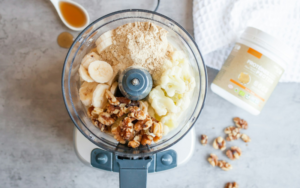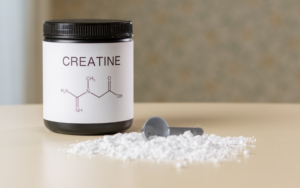There are three main kinds of whey, each with their own unique benefits.
When choosing the right whey protein for your nutritional needs, it’s essential to understand that not all whey proteins are created equal. There are three main types of whey protein, each with its unique characteristics and benefits. In this comprehensive guide, we’ll dive into these three types of whey protein: Whey Concentrate, Whey Isolate, and Whey Hydrolysate, to help you make an informed choice based on your fitness goals and dietary preferences.
Table of Contents
Where Does Whey Come From?
Before we delve into the specifics of each type, let’s first understand where whey protein comes from. Whey protein comes from the cheesemaking proces. Special enzymes added to the milk, so that the milk separates into curds (these are used to make cheese) and liquid whey. The whey protein is then pasteurized and dried so it can be used as a main ingredient in some drink mixes, protein bars and other foods [1].

Whey Concentrate Benefits
Whey Concentrate is one of the most popular forms of whey protein available on the market. It’s known for its versatility and balanced nutritional profile. Here are some key benefits and characteristics of whey concentrate:
Protein Content
Whey concentrate typically contains around 70-80% protein by weight, which means you get a substantial amount of protein with each serving. Therefor whey concentrate is an excellent choice for those looking to increase their daily protein intake.
Slow Digestion
One advantage of whey concentrate is its relatively slower digestion rate compared to other types of whey. This slower release of amino acids into the bloodstream can help maintain a sustained supply of nutrients to your muscles over a more extended period.
Rich in Nutrients
Whey concentrate retains a significant portion of the nutrients found in whey, including immunoglobulins and lactoferrin, which can support immune health.
Cost-Effective
Compared to other whey protein types, whey concentrate is often more budget-friendly, making it an attractive option for those looking for a cost-effective way to increase their protein intake.
While whey concentrate is an excellent allround choice for many people, it’s essential to consider your specific dietary goals and any potential lactose intolerance. Some individuals with lactose sensitivity may find that whey concentrate doesn’t sit well with them due to its slightly higher lactose content. In such cases, Whey Isolate might be a better alternative.
Whey Isolate Benefits
Whey Isolate is a highly refined form of whey protein known for its purity and rapid absorption. It offers several benefits that make it a top choice for many fitness fanatics and individuals with specific dietary requirements:
Exceptionally High Protein Content
Whey isolate is processed to remove almost all the fats and lactose, resulting in a protein content of around 90% or higher by weight. This makes Whey Isolate one of the purest sources of protein available.
Rapid Digestion and Absorption
Whey isolate is digested and absorbed quickly by the body, making it an excellent choice for post-workout recovery. The fast delivery of amino acids to muscles can promote muscle protein synthesis, aiding muscle growth and repair.
Low in Lactose
If you have lactose intolerance or are sensitive to lactose, whey isolate can be a suitable option. The extensive filtration process used to create isolate removes most of the lactose, reducing the chances of digestive discomfort.
Low in Fat and Carbs
Whey isolate is nearly devoid of fats and carbohydrates, making it an ideal choice for those on low-carb or low-fat diets who want to increase their protein intake without adding extra calories.
Suitable for High-Protein Diets
Whey isolate might be a great addition to your routine if you’re on a high-protein diet and want to reach certain protein goals without consuming too many extra calories from fats or carbohydrates.
Despite the fact that whey isolate has many benefits, it’s vital to remember that the additional processing may remove some of the beneficial substances present in whey concentrate. Depending on your objectives and dietary choices, you might also take into account a combination of whey isolate and concentrate, sometimes known as a “Whey Protein Blend” or “Tri-Blend.”
Whey Hydrolysate Benefits
Whey Hydrolysate is the most processed form of whey protein, and it’s often considered the most easily digestible. Hydrolysate is created through a process known as hydrolysis, which breaks down the protein into smaller peptides. Here are the key benefits of whey hydrolysate:
Rapid Absorption
Whey hydrolysate is pre-digested. It’s broken down into smaller protein fragments. This process makes it exceptionally easy for the body to absorb, making it an ideal choice for those who want quick protein delivery, such as athletes during and after workouts.
Reduced Allergenicity
The hydrolysis process also partially breaks down allergenic components, such as lactose. This makes whey hydrolysate a suitable option for individuals with lactose intolerance or milk allergies.
Gentle on the Stomach
Due to its pre-digested nature, whey hydrolysate is often the least likely to cause digestive discomfort or gastrointestinal issues, making it suitable for those with sensitive stomachs.

Low in Allergenic Proteins
It contains a minimal amount of intact proteins that can trigger allergies. This makes it a safe choice for individuals with allergies to milk proteins.
Used in Specialized Formulas
Whey hydrolysate is frequently used in infant formulas and medical nutrition products due to its excellent digestibility and reduced allergenicity.
While whey hydrolysate offers rapid absorption and is gentle on the stomach, it’s important to note that it may not have the same levels of intact proteins and bioactive compounds found in whey concentrate. As with any dietary choice, your selection should align with your specific goals and any dietary restrictions or sensitivities you may have.
In the following sections, we’ll discuss the concept of a “Tri-Blend” and how to choose the best whey protein based on your needs.
What is a Tri-Blend?
A Tri-Blend refers to a protein supplement that combines three types of whey protein: Whey Concentrate, Whey Isolate, and Whey Hydrolysate. This blend aims to provide a comprehensive and balanced protein source, taking advantage of the unique benefits of each type. Here’s a closer look at the concept of a Tri-Blend:
- Synergy of Benefits: By combining different types of whey protein, a Tri-Blend aims to offer a broader spectrum of benefits. This includes a balance between rapid absorption (from whey isolate and hydrolysate) and sustained release (from whey concentrate).
- High-Quality Protein: Tri-Blends often contain a high percentage of protein by weight, making them an excellent choice for individuals looking to maximize their protein intake.
- Reduced Lactose: The inclusion of Whey Isolate and Whey Hydrolysate in a Tri-Blend can contribute to lower lactose content, making it more tolerable for those with lactose sensitivity.
- Versatility: Tri-Blends can be used at various times throughout the day. They can serve as a post-workout recovery shake, a convenient meal replacement, or a protein boost in between meals.
- Flavor and Texture: Tri-Blends are known for their smooth texture and delicious flavors, making them an enjoyable addition to your diet.
Choosing a Tri-Blend can be an excellent option for individuals who want the benefits of all three whey protein types in one product. However, it’s essential to read product labels and understand the specific ratios of each type within the blend, as they can vary between brands.
What’s the best whey protein for me?
Choosing the best whey protein for your needs involves considering various factors, including your fitness goals, dietary preferences, and any dietary restrictions or sensitivities you may have. Here’s a step-by-step guide to help you make an informed decision:
Determine Your Fitness Goals
Start by defining your fitness or nutritional goals. Are you looking to build muscle, lose weight, increase over all protein intake, or support your general health? Understanding your objectives will guide your choice of whey protein.

Consider Lactose Sensitivity
If you have lactose intolerance or sensitivity, opt for Whey Isolate or a Tri-Blend with a higher proportion of isolate and hydrolysate, as they are typically lower in lactose.
Evaluate Protein Purity
If you prioritize high protein content and minimal fats and carbs, Whey Isolate may be your best choice. It offers the highest protein purity.
Assess Digestibility
Consider your digestive system’s sensitivity. If you have a sensitive stomach, Whey Hydrolysate is the easiest to digest, followed by Whey Isolate and then Whey Concentrate.
Budget Considerations
If you’re on a tight budget, Whey Concentrate is often the most cost-effective option. However, consider the trade-off with lactose content and lower protein purity.
Blend Versatility
A Tri-Blend can be an excellent compromise, offering a balance of rapid absorption, sustained release, and reduced lactose content. It’s versatile and suitable for various fitness goals.
Read Labels Carefully
Always read product labels to understand the protein type and ratio within a blend, as well as any additional ingredients or additives.
Try Sample Sizes
If you’re uncertain which whey protein type is best for you, consider trying sample sizes or smaller quantities to determine which one agrees with your taste preferences and digestion.
Remember that the “best” whey protein varies from person to person. What works well for one individual may not be the ideal choice for another. It’s essential to tailor your selection based on your specific needs and goals.
Wrapping Up
- Whey Concentrate is a versatile option with a balanced nutritional profile, providing moderate protein content, and retaining essential nutrients. It’s a cost-effective choice for those seeking a budget-friendly option.
- Whey Isolate is known for its high protein purity and rapid absorption, making it an excellent choice for post-workout recovery or low-carb diets. It’s also suitable for individuals with lactose intolerance.
- Whey Hydrolysate is the most easily digestible form of whey protein, ideal for those with sensitive stomachs or allergies. It offers rapid protein absorption and reduced allergenicity.
- Tri-Blends combine all three types of whey protein, aiming to provide a comprehensive protein source with a balance of benefits. They can be a versatile choice for various dietary needs.
Ultimately, the ideal whey protein option is the one that aligns with your specific needs, has a great taste to you, and helps you achieve your health and fitness goals. Whether you’re looking to build muscle, support weight loss, or increase your daily protein intake, there’s a whey protein type that can fit your lifestyle.
Curuious about the other possibilitys of protein powder, check out 7 best types of protein powder.
Thank you for reading, and we hope this guide has been helpful in your quest for the perfect whey protein source.
Sources
- https://www.usdairy.com/news-articles/what-is-whey-whey-protein-101#:~:text=Whey%20protein%20comes%20from%20the,protein%20bars%20and%20other%20foods.



